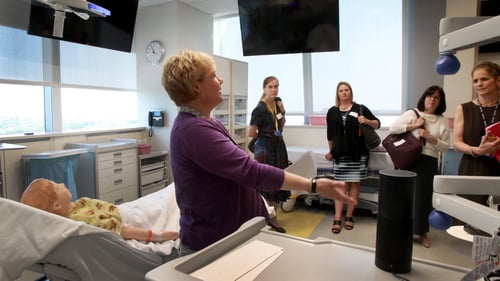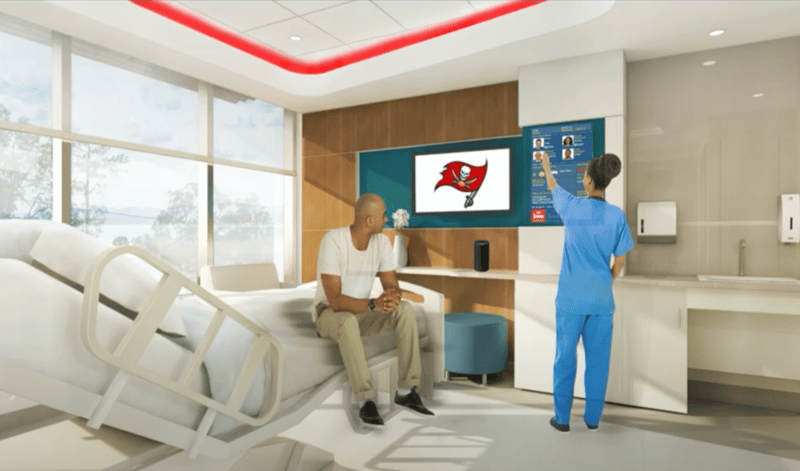The hospital of the future isn't far away. In fact, in some cases, it's already being piloted and finessed at health systems around the world.
From voice automation to facial recognition, healthcare facilities have begun to experiment with hi-tech components that were once only seen in futuristic movies.
Brendon Buckley, healthcare technology director at Johnson Controls, shared the innovations and technology being used to shape the smart hospital of the future with HealthSpaces.
"We specialize in clinical systems, facilities, IT, and pulling it all together," he said. "If you think about it, we're creating the smart hospital. We're on a journey together. We've heard about all this exponential change happening. You hear stuff and think it's Star Trek and all far out. But it's happening."
While your next stay in the hospital likely won't include robot nurses or automated medication dispensers, there are a number of smart tech elements quickly making their way into hospitals across the country.
Buckley highlighted the work going into creating these hospitals of the future. Read on to learn just how integrating our healthcare system with data collection, automation and artificial intelligence will shape much smarter facilities.
Laying the Groundwork
"You have to start with system integration," Buckley said. "About 10 years ago we were so excited that we could make systems and IT all run-on the same wire. We did that, we saved some wiring and infrastructure. That was good."
But it was just the beginning. Once that system was in place, the opportunities for future integration and programming became endless.
For instance, hospitals are a hotbed for information, or personal data. Buckley notes that healthcare providers can use that information to craft systems that anticipate and respond to patient needs.
"Let's pull it all together and do data aggregation," Buckley said. "So now, there's this unstructured data coming in. You hear it as a data lake, but it's a data swamp, it's messy."
This messy data, once organized and identified, can be used for the next step in the process, automation and response.
"That's where we are today," Buckley said. "Between data aggregation and automation and response. That's taking data and doing things with it, like alerts, analytics, dashboards, helping us to make decisions."
Today's Smart Hospital
Each of these elements lay the groundwork for the smart hospital, some of which are already in the works today.
"The smart hospital is already moving quickly today," Buckley said. "As we're building facilities today, what is pushing the envelope with today's technology?"
A number of healthcare organizations are testing or building pilot rooms in order to test technology made possible through system integration, data aggregation and automation and response.
"It's exciting, but the thing that's really interesting is we started off by asking 'how do we put control back in the hands of patients?'" Buckley said.
The answer, he said, was creating automation systems that tie in all elements of technology to allow patients control of their rooms. For instance, letting patient's control temperature, the blinds, lights, and other things.

E.g. Boston Children's Hospital tested Alexa |
"We can even take it a step further and provide a bring-your-own-device app," he said. "So patients get to the room and they can control their room from their phone."
A recent smart hospital development Buckley has worked on relates to voice automation.
Using Amazon's Alexa assistant, the system allows patients to simply say "I'm hot," or "I'm cold" and have the temperature automatically adjusted. In the future, he hopes the controls will allow for non-clinical application, such as producing a blanket when a patient states “I need a blanket.”
Smart Safety
Buckley notes that smart hospitals aren't just for the patient, but for staff, too.
"Staff safety is a big issue," he said. "How do we provide them a level of security for patients with distressed family members, patients on medications, other staff members. Healthcare is not the safest place to work if we're honest."
In response, Buckley said some hospitals have begun using smart employee badges, which include a distress button.
"If staff hit that button, it automatically notifies security. Their location shows up in the command system and they know where to go," he said.
Buckley shared a story about a hospital that was deploying such a system. While he was conducting a walkthrough with the chief nursing officer, she hit the distress button on her badge and began timing the response from security.
"They get there and everything is fine and they leave," Buckley said. "I'm doing a mental hi-five because it took them one and a half minutes to arrive, that's pretty good. But she says to me 'would you like to be choked for one and a half minutes?'"
The answer, of course, is no. But that's the reality for healthcare workers. If a violent patient begins attaching them, a one and a half minute response time could be too long.
"So what do you do?" Buckley asked.
In this case, the answer was leveraging each of the elements for a smart hospital and making them work together.
"We have systems integration, so we can tie the nurse call, tie in their mobile devices, tie in security," Buckley said. "We know where they are, so we can find the 10 closest people to the incident and notify them, and send an alert to their phones. They could be right next door, that would take the response from one and a half minutes to 10 seconds."
Smart Convenience
Buckley notes that the current technology can also be used to create more convenient access for patients and visitors.
 |
"One thing that drives patients crazy is being on an elevator and it stops at five different floors and staff are getting on and off," he said. "We can put a sensor in the elevator, when it detects a patient, it can tell the elevator not to stop at all the floors. It's simple stuff but it goes a long way for patient experience."
Similarly, Buckley says hospitals can leverage data and automation to create more streamlined parking.
"You can use a lighting system that shows green and red lights for available spaces," he said, adding that the system can also be used to help patients find the way to their appointments.
"We can use license plate readers when you come in to track you and show you with lights where to park," he said. "The other part of that is sending you a text message when you arrive with directions to where you're going."
A Social Element
In some areas, healthcare systems are taking these integration, automation and aggregation elements a step further to reach patients.
Buckley said that in Asia, such systems have been integrated into WeChat.
"When we do projects in China we interface WeChat to do scheduling, checking queue times in different departments and for payroll or billing," he said. "This is where we're heading. This is where it gets interesting."
The Next Steps
While the social media element is certainly a piece of the smart hospital worth exploring in the U.S., Buckley said there are other systems on the horizon.
For example, Buckley foresees using a lot more artificial intelligence in the healthcare field.
"With AI, the machine learning piece, those are probably the most exciting and potential breakthroughs we're testing in healthcare today," he said. "That is something we are looking at probably as one of the biggest advances in our existence today. And it's modeling after our own minds and recalling and improving the way we access information."
Buckley said that using AI would enable the use of other technologies such as facial recognition. Such a system could scan a patient's face as they enter a building and then cross-reference that with schedules for the healthcare provider, essentially checking-in the patient as they entered the building. Additionally, these systems, coupled with the data aggregation, can also help in developing the adaptive patient room, Buckley said.
"We're so excited to have smart patient rooms and doing environmental control," he said. "What if the room knows more about you? What if it knows where you're from, your favorite hobby or sports team. This could elevate patient care."
The current Covid-19 crisis has only accelerated all of this. Now there are new technologies to tie together including ventilation systems, contact tracing and thermal cameras to help protect those accessing services and quickly respond to spikes in patient volume.
With the smart hospital on the horizon - or in some cases, already in place - Buckley warned that we should be cautiously supportive, aware of the risks, but not shut off by them.
"We need to manage the risks and move forward because it’s happening," he said. "It is coming faster than you think."

Posted by
Collaborate with your Peers!
HealthSpaces is a community for people that plan, design, build and operate spaces where healthcare is delivered.
June 7-9, 2026 | Braselton, GA
Learn More




-4.png)
-Dec-09-2025-05-48-44-4379-PM.png)
-4.png)
-1.png)
-2.png)

Comments